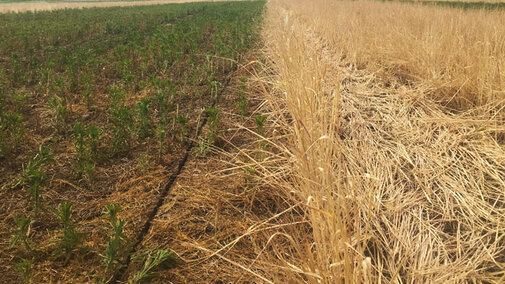The following article by Eric Oseland, graduate research assistant, and Kevin Bradley, state extension weed scientist, for University of Missouri, is reprinted from the University of Missouri's Integrated Pest Management newsletter with permission.
Cover crops can serve as a useful tool of an integrated weed management program. Our research has shown that cover crops such as cereal rye can provide good control of winter annual weeds and other troublesome species like horseweed (Figure 1), and also provide early-season suppression of summer annual weeds like waterhemp. However, proper spring termination of cover crops is important in order to be able to plant your cash crop successfully, and also to prevent any of the surviving cover crop from competing with the cash crop. We have recently published the results from a multi-state study funded by the United Soybean Board on cover crop termination. We are sharing the final results of this study in this article, and they can also be found as a slideshow on our website.
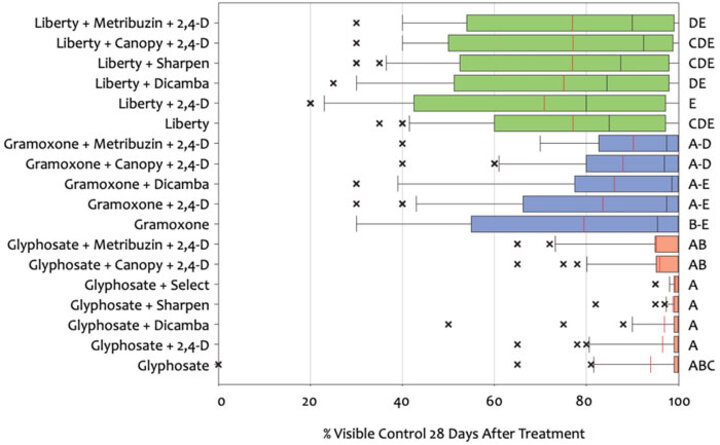
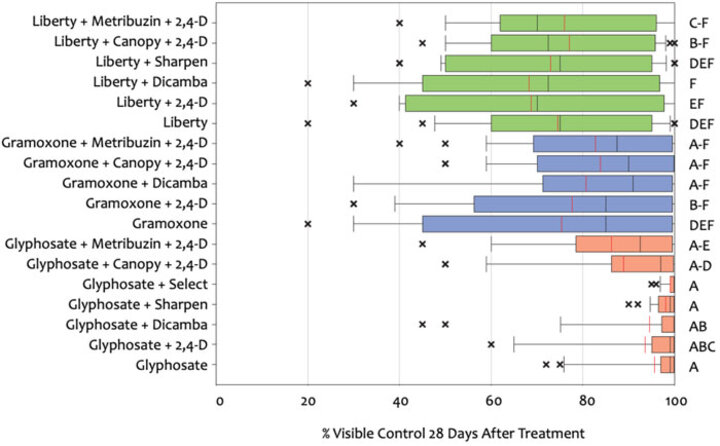
In this research, we evaluated the control of 9 different cover crop species with common herbicide treatments. Three base herbicide treatments (glyphosate, glufosinate, paraquat) were applied to each species either alone or mixed with combinations of 2,4-D, dicamba, saflufenacil (Sharpen), clethodim (Select Max), metribuzin, and chlorimuron (Classic) in order to determine the most effective and consistent treatment for the control of each species. The results are presented as box and whisker graphs, as this is a good way to visualize the variability of a given treatment when applied across a variety of locations. When viewing results in these graphs, it is perhaps most important to view the mean (the red line) for each treatment, but take note that the bigger the "box" and the longer the "whisker", the more variable that treatment is when applied across numerous years and environments. Small "boxes" with small "whiskers" are indicative of treatments that are much more consistent across a wide range of environments and application timings.
Terminating Grass Cover Crops
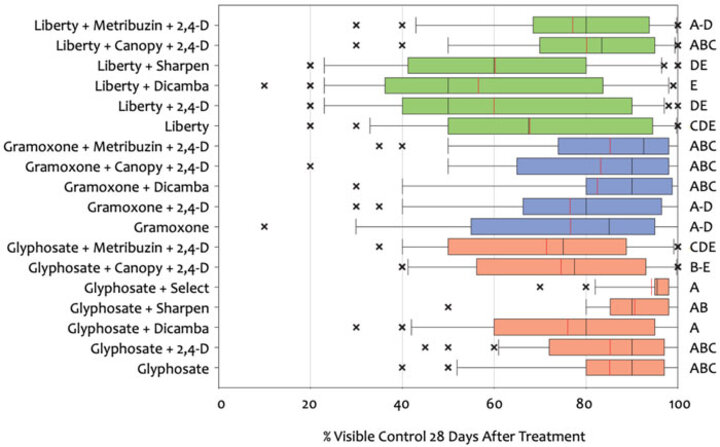
The grass cover crop species evaluated in our research were annual ryegrass, cereal rye, triticale, and wheat. Figures 2, 3, and 4 show the results pertaining to cereal rye, wheat, and annual ryegrass.
As illustrated in Figures 2-4, herbicide programs that included glyphosate were more effective on grass cover crop species than those that included Gramoxone (paraquat) or Liberty (glufosinate). Contact herbicide like glufosinate and paraquat are often less effective on grass species because of their inability to translocate and adequately terminate the growing point in the way that systemic herbicides such as glyphosate can. Glyphosate plus dicamba, 2,4-D, Sharpen, or Select were most effective in controlling grass species. The data in Figure 4 also illustrates that not all cover crop species should be viewed equally. While several treatments controlled cereal rye and wheat consistently over numerous states and years (small boxes), the boxes and whiskers in Figure 4 illustrate how much more difficult it can be to control annual ryegrass. For many years weed scientists have cautioned the planting of annual ryegrass as a cover crop (not to be confused with annual rye or cereal rye) for this very reason. In this research, the most consistent treatment for annual ryegrass has been high rates of glyphosate (>36 ozs) plus 16 ozs SelectMax (or some other generic clethodim product).
Terminating Legume Cover Crops
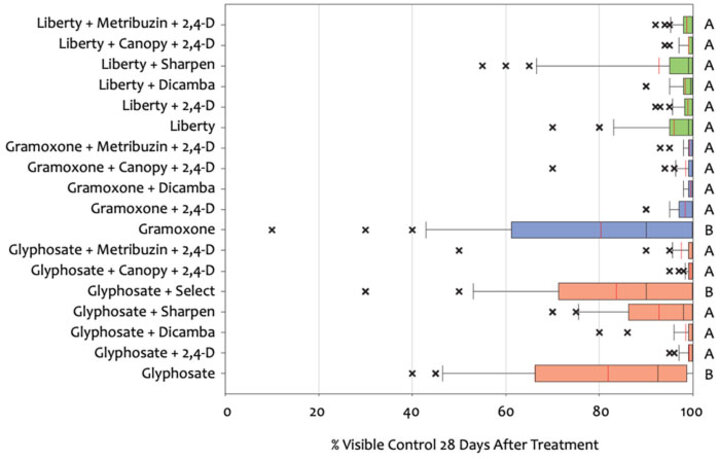

Figures 5 and 6 illustrate the results from our experiments pertaining to the termination of hairy vetch and winter pea. In contrast to the grass cover crops, treatments that contained glufosinate or paraquat were as effective as glyphosate in controlling these legume cover crops when mixed with the appropriate tank-mix partner. In general, any of the base treatments that were mixed with a synthetic auxin such as 2,4-D or dicamba were most effective. The addition of Sharpen (saflufenacil) to glyphosate was also an effective treatment for the control of these legume cover crop species. Although clover was not a primary component of this research, we did evaluate clover control in a similar study we conducted from 2013 to 2015. In this research, >90% control of crimson clover was achieved with glyphosate plus 2,4-D, dicamba, or Sharpen when applied in early April to 4 to 7.5-inch-tall plants. However, control was only 71 to 83% when these same treatments were applied to 8 to 12.5-inch-tall clover in early May. Â Paraquat plus 2,4-D provided 90-95% the control of clovers in this study at either timing. Although we did not include paraquat plus dicamba in that previous research, it is likely that this treatment would provide similar or better control of clover species than paraquat plus 2,4-D.
Additional Considerations for Cover Crop Termination Applications
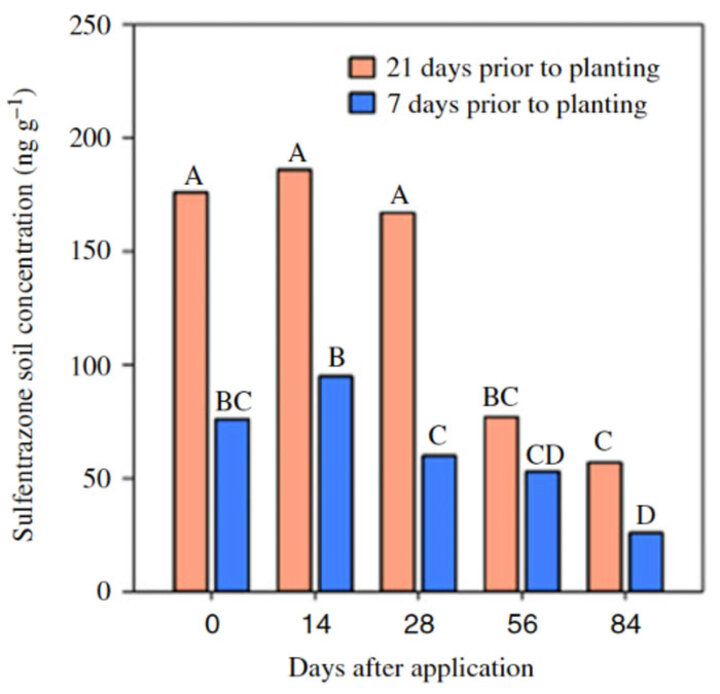
Another very common question we often receive is whether or not to include a residual herbicide in with these burndown treatments when terminating cover crops. We conducted a separate experiment in 2016 and 2017 to investigate these issues, and Dr. Bob Hartzler and Meaghan Anderson from Iowa State University have recently provided an excellent summary of this research here. We encourage everyone to read that summary as we won't go into all of the details of that research within this article. In a nutshell though, the quick take-home message from that work is this: the size of your cover crops at the time of termination should be the primary factor that helps you decide whether or not to include the residual herbicide. Our research suggests that when cover crops are terminated 2 to 3 weeks before planting and/or are less than 12 to 18 inches in height, residual herbicides can usually be included with the burndown treatments without adverse effects.
In this scenario, there is usually not enough cover crop biomass to cause an appreciable reduction in the amount of residual herbicide that reaches the soil (Figure 7). However, when termination is delayed closer to planting and the cover crops are much larger, it is likely that the biomass will not allow the residual herbicide to reach the soil surface and therefore it would NOT be available for uptake by germinating weed seeds. So, if it is more typical in your operation to delay cover crop termination until closer to planting, our results would encourage you to leave the residual herbicide out and include it at the time of the first post-emergence herbicide application.
Other Resources
2020 Mizzou Weed Science Virtual Field Day Video 4: Corn Weed Management and New Corn Herbicides (07/22/20)
Eric Oseland
Graduate Research Assistant, University of Missouri, Division of Plant Sciences
Kevin Bradley
State Extension Weed Scientist, University of Missouri, Division of Plant Sciences
